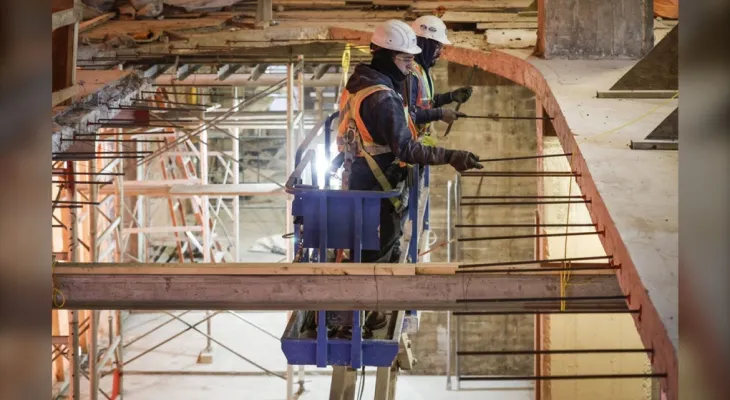Search here
Newspaper
Search here

Arab Canada News
News

Published: January 8, 2024
No community anywhere would willingly choose to have an office vacancy rate approaching 30 percent in the heart of downtown.
But facing this problem, one Canadian city has come up with a plan now considered a model for the rest of the country amid the ongoing national housing crisis.
Calgary has been busy converting unused office towers into residential apartments, thanks to the city's unique incentive program for developers.
Within just two years, the program has led to the approval of 13 office-to-residential conversion projects, with four more projects still under review.
The first project, converting a 10-story underutilized office building at a cost of $38 million into 112 residential units, is nearing completion and is expected to open early this year, with several other projects currently under construction.
Advocates explained that the program's early success showed that office-to-residential conversion can work and that the idea could be part of the solution in a country facing a massive shortage of residential units.
Walsh Manas, Managing Director of Avison Young Commercial Real Estate, said about Calgary’s downtown development incentive program, "I think this can work in any major city, especially any major Canadian city, because from my perspective, we are all struggling to provide enough homes."
"Any market where municipalities incentivize residential development, I believe it can be successful to varying degrees."
Calgary’s downtown development incentive program, which offers $75 per square foot to building owners looking to convert unused office spaces into residential apartments, is unique in North America.
Launched in 2021, at a time when the city — home to more corporate headquarters per capita than anywhere else in Canada — was reeling from a prolonged oil price slump and the Covid-19 pandemic.
Commercial property values in the downtown core collapsed due to a wave of layoffs in the energy sector and mergers that left nearly a third of downtown Calgary office space empty.
In a desperate attempt to fill nearly 13.5 million square feet of vacant space and bolster its shrinking tax base, Calgary launched the incentive program aimed at removing six million square feet of vacant offices from downtown by 2031.
Cheryl McMullin, who runs the program for the City of Calgary, said it was unclear at the time how it would be received.
But the program proved so popular that by October 2023, the city had to temporarily pause it after reaching the $253 million funding cap.
“When we launched the program, we didn’t know if we would get one application or 10.”
“We ended up with 15 in the first round alone, so we knew we’d done something right when we had that many interested building owners.”
The Canadian housing crisis
An estimate from Canada Mortgage and Housing Corporation indicates that 3.5 million additional new units need to be built by the end of the decade to provide affordable housing to those who need it.
Greg Kwong, managing director of CBRE commercial real estate in Alberta, said office-to-residential conversions are not a magic solution but can be part of the puzzle.
He noted that many cities are facing excess downtown office space following the pandemic and the trend of working from home.
Kwong said, “It’s not the cure-all, it’s just one of many levers we have to pull to make downtown cores more vibrant again.”
“This is a problem that will affect cities more than just Calgary.”
In the third quarter of 2023, Avison Young statistics show commercial vacancy rates in downtown Vancouver and Toronto reached 12.5 percent, while Ottawa’s downtown commercial vacancy rate was 14.7 percent.
And in both Edmonton and Montreal, more than 20 percent of available downtown office space is vacant.
Manas said, “Toronto, Vancouver and Montreal office markets are still in much better shape than Calgary, but these cities are also struggling with the post-Covid office market.”
He added, “I think it will take some time to deal with the new reality of vacancies, and depending on how large these vacancies become, office-to-residential conversion becomes a better opportunity.”
Ken Toews is Senior Vice President of Development at the Calgary-based Strategic Group, a developer that has completed three office-to-residential conversion projects in Alberta without the help of an incentive program.
While he is a strong advocate of this model, Toews said most potential conversion projects require some form of government support to become financially viable.
Toews, whose company is now working to convert an empty heritage office tower in Calgary called the Baron Building into rental residential suites, said, “Buildings were never intended to be developed into apartments.”
“There are lots of design issues, and many developers won’t touch them because they represent a huge challenge.”
Toews continued that converting an office tower into a residential building requires creativity and finding solutions for oddly shaped floor plates, unusually located elevators, and in some cases, lack of windows.
But while these complexities can make office conversions costly, they still take much less time than building new from the ground up.
Toews added they also have a much smaller carbon footprint than new buildings, with the added benefit of bringing new life and vitality to tired downtown areas.
Toews said that as more conversions are completed and developers and architects gain more experience, a wide range of buildings will become viable candidates.
He said developers from across Canada have already contacted him who are looking to learn lessons from Calgary's experience.
Adding, “We know this is part of the solution to the housing crisis, and it could possibly work in any city if the city is willing to provide an incentive.”
“We have a big challenge in this country regarding housing, and as you know, I think we need to explore and make sure as many people as possible are working on it and be creative in our solutions.”
Comments